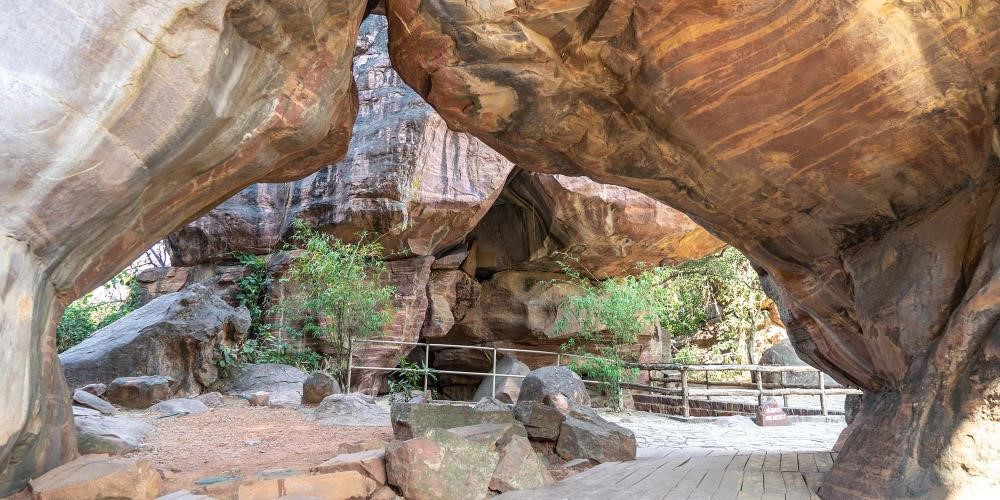Historical Places
Historical Places
Bhimbetka Rock Shelters
- Bhimbetka Rock Shelters, Madhya Pradesh: The Earliest Traces of Human Life on the Indian Subcontinent
- Nestled in the foothills of the Vindhyachal Range in Madhya Pradesh, about 45 km away from Bhopal, Bhimbetka is home to ancient rock shelters where the earliest human life on the Indian subcontinent existed hundreds of centuries ago.
- Evidence suggests that these rock shelters are where the South Asian Stone Age began. Many of these caves feature prehistoric cave paintings dating back to even 300 centuries.
- With over 750 rock shelters and caves dotting Bhimbetka, some of which were occupied by human inhabitants more than 1000 centuries ago, the place attracts history buffs, archaeologists, and travelers from all around the world.
History
- Bhimbetka comprises of five clusters of rock shelters distributed across an area of 10 km, spanning seven hills. The archaeological significance of Bhimbetka remained unknown to the modern world for a long time.
- Though a reference to the site was made in 1888 in a scholarly paper by W. Kincaid, an official of British India, he mentioned it as a Buddhist site. Much later, an Indian archaeologist named Vishnu Shridhar Wakankar discovered these rock shelters in 1957.
- The real significance of these caves, however, was realized only in 1970. After that, over 750 rock shelters have been discovered on the site as of now. Out of these, 243 are part of the Bhimbetka group while 178 are part of the Lakha Juar group situated nearby.
- Based on the excavations conducted at Bhimbetka and the artifacts and rock paintings discovered on the site, the Archaeological Survey of India has concluded that the rock shelters were continuously occupied until the 2nd century BCE.
Rock Paintings at Bhimbetka Rock Shelters
- Bhimbetka Rock Shelters possess the oldest rock paintings known to exist in the Indian subcontinent.
- Out of the 754 rock shelters recognized till now, 400 shelters feature impressive rock paintings that span a vast period of time, starting from 30000 years ago to the medieval age.
- The themes and motifs featured in these paintings, such as hunting, dance, animals, geometric figures, etc. provide insights into the cultural evolution of humans.
- The colors used for the paintings are vegetable colors that have stood the test of time. Interestingly, the 21 villages located around the Bhimbetka archaeological site reflect the customs or traditions expressed in the paintings.
Bhimbetka Rock Shelters: Today
- Today, Bhimbetka is one of the largest prehistoric complexes in India and a top tourist attraction in Bhopal.
- The floors and stone walls of these rock shelters are touted as the oldest in the whole world.
- The archaeological site was declared as a protected site and came under the maintenance of the Archaeological Survey of India in 1990 while UNESCO declared it as a World Heritage Site in 2003.

Things to see at Bhimbetka Rock Shelters
Though the Bhimbetka complex comprises hundreds of shelters, visitors are allowed to explore only 12 to 15 of them. The major things to see at Bhimbetka include:
- Auditorium Cave, the largest cave at the site which stands bordered by quartzite towers
- Paintings of prehistoric times in which humans are depicted as hunters and food gatherers
- Paintings of historic times that feature fighters, elephants bearing metal weapons, riders on horses, and battle scenes where rulers carry spears, swords, arrows, and bows
- Zoo Rock that features paintings of various animals, such as elephants, deer, bison, and swamp deer or barasingha
- Nataraj Painting, a desolate shelter featuring a unique painting of a man dancing with a staff that looks like a trident
In addition to these, the rock shelters also feature paintings of magical chariots flying in the sky, tree gods, religious symbols, communal dances, children and mothers, dead animals being carried by men, burials, cooking, drinking, honey collection, childbirth, and so much more.
Lesser-Known Facts about Bhimbetka Rock Shelters
- Bhimbetka derives its name from Bhim, one of the Pandava princes from the Mahabharata. According to legends, Bhim sat at this location when the Pandavas were in exile. Since the word sat translates to baitha in Hindi, the place was called Bhimbetka which means the place where Bhim sat.
- It is presumed that the rock art in at least 100 shelters may have been lost to time.
- The site has a rather mysterious painting of a man being attacked by a huge red bison. The uniqueness of this painting is that it can be seen only when the sunlight is just appropriate.
- Most of the rock art is done on the ceilings of the shelters.
- Archaeologists believe that 21 colors have been used in the Bhimbetka rock paintings.
- The rock shelters of Bhimbetka are a fascinating place to look back at the evolution of mankind. Whether you are a history buff, an art enthusiast or a just traveler trying to unravel the mysteries of the past, this ancient art gallery of India will keep you engaged for hours.
Trips
& tours
Choose M.P Holidays®
- Approved by “The Ministry of Tourism” (Approval No: 2203270HE874)
- “The Official No.1 Channel Partner” of M.P Tourism (Registration No: MP-TOUR-20221/131888)
- We are Awarded “The Best Travel Agent” by M.P. Government for the three consecutive years. (2016, 2017 and 2018)
- Having offices at
- Surat
- Indore
- Ahmedabad
- Pachmarhi
- Nagpur
- Kanha
- Discover Madhya Pradesh from major cities like Surat, Ahmedabad, Delhi, Mumbai, Nagpur, Pune and beyond—experience the best of India, no matter where you start.
- Own resort at Madhya Pradesh.








